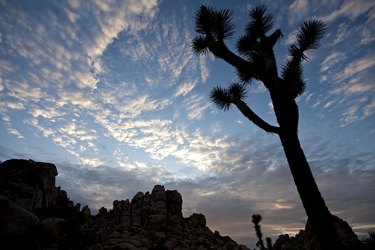
Few yards truly lend themselves to growing the desert-dwelling Joshua tree (Yucca brevifolia), known for its quirky silhouette and spiky foliage. If you live in its preferred climate of U.S. Department of Agriculture plant hardiness zones 7 to 10 and have a sunbaked, sandy or gravelly site, however, the distinctive tree may fit the bill perfectly. Among the many methods for propagating the Mojave Desert native, growing a Joshua tree from seed is a viable option – under the right conditions.
Fresh Is Best for Germinating Joshua Tree Seeds
Video of the Day
Your best bet for ensuring germination is to start with fresh Joshua tree seeds – preferably those gathered the previous season. If you are harvesting Joshua tree seeds yourself, gather seedpods just before winter. Once the pods dry, crush them to release the pod's interior seeds. The seeds stay freshest when kept in bags of damp sand in the refrigerator. If you can't plant within one year, set the seeds in airtight containers and place the containers in the refrigerator.
Video of the Day
Seed Sowing Strategies
For the most part, Joshua tree seeds don't need special treatment before sowing, such as scraping their surface. To encourage faster germination, however, soaking the seeds for about 24 hours before sowing them may help. A 4- to 6-inch pot with drainage holes and filled with seed-starting soil will enable the seedling to grow undisturbed without the need to transplant from pots, but starting them in flats and gently moving them to larger pots is also an option. Sow each seed to a depth of about 1/2 inch. They germinate more reliably when set in full sun, at a temperature of 60 to 70 degrees Fahrenheit.
Joshua Tree Seedling Care
Keep your Joshua tree sapling moderately well watered and in a warm, sunny place until transplant time. Plan to transplant the young tree in late fall or early spring. If you're on the cooler end of the spectrum for growing the desert fixture, keeping the young Joshua tree inside for more than a year can give it a sturdier start when facing its first outdoor winter. As the sapling grows, repotting to increasingly large containers with drainage holes may be necessary until the final transplanting occurs.
Ground Prep for Joshua Trees
Improving drainage over a large area becomes crucial when establishing Joshua trees. Not only do the Mojave natives demand drainage that emulates their natural desert environment, their shallow root system can also spread several yards away from the trunk. Adding several wheelbarrows' worth of sand or gravel can help, as can creating a raised mound in which to plant the sapling. To test if you've achieved the proper drainage, fill the planting hole with water. If it drains within a three-hour period, the drainage is likely adequate.
Best Cultural Practices
Because Joshua trees don't do well in rich soils, you won't need to fertilize the growing area at planting time or in subsequent seasons. Instead, maintaining drainage is much more crucial. Eradicate depressions that form near your tree with a layer of gravel or a sandy raised mound to avoid standing water. First-year saplings appreciate a watering of about 2 gallons of water once or twice per week in the summer and a thorough watering every two weeks during hot weather in subsequent years.
- Encyclopedia of Life: Yucca Brevifolia
- Lady Bird Johnson Wildflower Center: Yucca Brevifolia
- U.S. Forest Service: Yucca Brevifolia
- Royal Horticultural Society: Trees and Shrubs from Seed
- University of Arizona: A Guide to High Desert Landscaping
- Desert USA: Joshua Tree
- U.S. Forest Service: Success Story